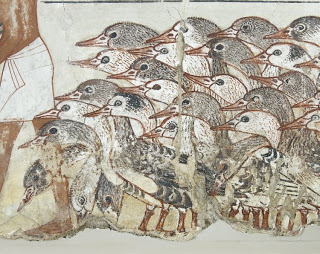Egypt
 Huliq.com
Huliq.com
See the above page for the full story
- Nebamun: A Happy Ending With A Pinch Of Salt
Al Ahram Weekly (Jenny Jobbins) UPDATE: Jenny Jobbins correctly pointed out that I copied the word "Salt" as "salt". I have corrected it above. Apologies to all. I thought that we had seen the end of reviews of the Nebamun gallery at the British Museum,...
- Nebamun's Painted Chamber
The Guardian (Richard Parkinson) Richard Parkinson is a curator in the Department of Ancient Egypt and Sudan, at the British Museum. Later this month he'll be opening a major new permanent gallery, one that will display the famous wall paintings from...
- Nebamun Galleries - Raiders Of The Lost Art
The Guardian (Robin McKie) I am hoping to visit the Nebamun exhibits next week with a friend who is an expert on ancient Egyptian wildlife, so I will report back when I've had the chance to see it. I am looking forward to the visit enormously. These...
- More Re New Nebamun Gallery At The British Museum
Suite 101 (Stan Parchin) As usual Stan has written an excellent overview, looking at the background to the Nebamun paintings, the restoration work and the new gallery. Excavated from the tomb-chapel of Nebamun, now lost, the 11 paintings represent a...
- New Gallery At The British Museum
A new gallery is set to open this winter at the world famous British museum. The gallery will be centered around the 11 Nebamun tomb chapel fragments ca. 18th dynasty. http://www.artdaily.com/index.asp?int_sec=2&int_new=25791...
Egypt
More re new Nebamun gallery at the British Museum
 Huliq.com
Huliq.comThe tomb-paintings were acquired by the Museum in the 1820s and were constantly on display until the late 1990s. Since then, the fragile wall-paintings have been meticulously conserved, securing them for at least the next fifty years. The project has provided numerous new insights into the superb technique of the painters called by one art-historian ‘antiquity’s equivalent to Michelangelo’ - with their exuberant compositions, astonishing depictions of animal life and unparalleled handling of textures. New research and scholarship have enabled new joins to be made between the fragments, allowing a better understanding of their original locations in the tomb. They will now be re-displayed together for the first time in a setting designed to recreate their original aesthetic impact and to evoke their original position in a small intimate chapel. The gallery will include another fragment for the same tomb-chapel on loan from the Egyptian Museum, Berlin. Drawing on the latest research and fieldwork at Luxor, a computer ‘walk-through’ of the reconstructed tomb-chapel will be available in gallery with an interactive version online.
Next to the paintings, 150 artefacts show how the tomb-chapel was built, how it remained open for visitors, and also the nature of Egyptian society at the time. Most of the objects are contemporary with Nebamun and reflect those depicted in his paintings. Some, however, contrast with the idealised world-view that is shown on elite monuments like the tomb-chapel and show that most people’s experience of life was not necessarily all about leisure and prestige as in the paintings. Spectacularly luxurious objects, such as a glass perfume bottle in the shape of a fish, are juxtaposed with crude tools of basic survival, such as a fishing net, to suggest that most of what we know of Ancient Egypt is about the small wealthy elite.
See the above page for the full story
- Nebamun: A Happy Ending With A Pinch Of Salt
Al Ahram Weekly (Jenny Jobbins) UPDATE: Jenny Jobbins correctly pointed out that I copied the word "Salt" as "salt". I have corrected it above. Apologies to all. I thought that we had seen the end of reviews of the Nebamun gallery at the British Museum,...
- Nebamun's Painted Chamber
The Guardian (Richard Parkinson) Richard Parkinson is a curator in the Department of Ancient Egypt and Sudan, at the British Museum. Later this month he'll be opening a major new permanent gallery, one that will display the famous wall paintings from...
- Nebamun Galleries - Raiders Of The Lost Art
The Guardian (Robin McKie) I am hoping to visit the Nebamun exhibits next week with a friend who is an expert on ancient Egyptian wildlife, so I will report back when I've had the chance to see it. I am looking forward to the visit enormously. These...
- More Re New Nebamun Gallery At The British Museum
Suite 101 (Stan Parchin) As usual Stan has written an excellent overview, looking at the background to the Nebamun paintings, the restoration work and the new gallery. Excavated from the tomb-chapel of Nebamun, now lost, the 11 paintings represent a...
- New Gallery At The British Museum
A new gallery is set to open this winter at the world famous British museum. The gallery will be centered around the 11 Nebamun tomb chapel fragments ca. 18th dynasty. http://www.artdaily.com/index.asp?int_sec=2&int_new=25791...
